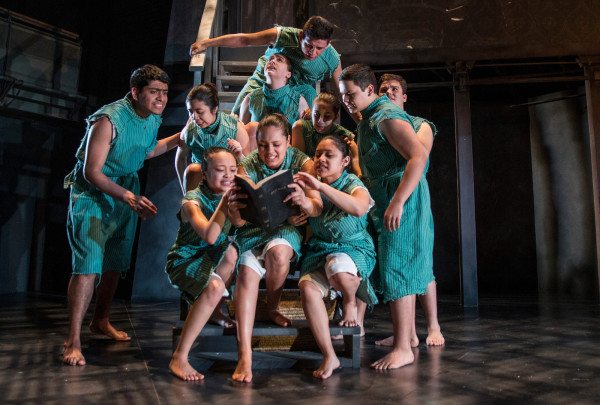Remembering how we learned to love is not something we think about often. However, in God’s Work, Rachel remembers the moment clearly when she was 10 years old and holds on to the story for it to be told.
The true story of Rachel and her journey has come to the Goodman Theatre in the new production God’s Work. The production is produced by the Albany Park Theatre Project (APTP), and it runs through April 19 in the Owen Theater at Goodman Theatre (170 N. Dearborn St.).
Drawing upon a vast array of societal and cultural issues primarily in Albany Park — an area just a few neighborhoods southwest of Rogers Park — APTP has been performing original plays with innovative elements since 1997. The project’s objective is to expose audiences to stories they would have never heard otherwise.
God’s Work portrays the issues connected to abusive relationships within a family in a brilliantly imaginative way. The play is based on Rachel, a former APTP member who had a disturbing childhood.
Vincent Meredith plays Rachel’s father, an extremely patriarchal Christian who attempts to control every aspect of his wife and children’s lives. Besides going to school, the children are always kept in the basement where they are forced to memorize Bible verses and do chores. Any minor indiscretion, such as putting a bow in one’s hair or taking a break during chores, leads to physical punishment.
The portrayal of the physical punishment is one of the most striking and creative aspects APTP uses for the production. Meredith takes a variety of paint and paintbrushes to color the children’s bodies, symbolizing physical and emotional abuse.
After the young actors are painted, they turn to the audience and announce the abuse they had endured and were physically representing. Some of the abuses depict the children eating their own vomit or inflicting pain upon their own siblings.
As the play progresses, each child is covered in multiple colors. Audiences get a vivid, but horrific visual of the extent to which these children suffered cruelty at the hands of their father.
Furthermore, each young actor portraying a child of the family did an excellent job at visually and audibly showing their pain. Their screams of agony were extremely realistic and elicited goose bumps.
Another stylistic element that really stands out in God’s Work is the set design. The Goodman Theatre’s Owen Stage is split into two tiers. The main floor is used as the basement where the children live and the second floor holds the kitchen where interactions between the parents take place.
A narrow staircase leads up from the first tier to the second and oftentimes the father stands at the top of the stairs and talks down to his children, giving them commands.
The stage setup is crucial because the audience truly gets the dark and hopeless feeling of being in the basement alongside the children. It is a great way for the audience to step into the lives of these children and the pain they endure throughout the performance.
Additionally, the top tier is covered in blinds that open and close at specific moments throughout the play. When the blinds are open, they give the audience an inside peek at the occurrences in the kitchen. When they’re closed, the blinds contribute to the dark and empty atmosphere the children constantly live in.
The young actors (18 of which play children and four of which play adults) are yet another aspect that contributes to the outstanding performance. All of the actors are under the age of 19, but their acting makes them seem like true professionals. Even the four actors that played adult roles were exceptionally mature and able to embody their characters.
While there are not a lot of spoken lines, the young actors are still able to convey an immense amount of emotion through their movement and body language. As a result, the play is enhanced by multiple dances that string together to fluidly reveal the harrowing story.
One of the best scenes of God’s Work is when Rachel (Maidenwena Alba) takes a break during chores and engages her siblings in a playful and artistic dance. The young actors march around the stage pretending they’re in a circus as multicolored lights shine down.
This scene in particular shows the talent of the designers for God’s Work and the complexity of the play as a choreographed work of art.
The scene also shows the youthful and funny sides of the children’s personalities. They live such deprived lifestyles, often cold and hungry, but the circus scene reminds the audience that these are children with imaginations and a willingness to reach for the freedom beyond the tyrannical rule of their father.
Whether it is pretending to be performers in a circus or animals in a jungle, the children’s imaginations are endearing. However, all too quickly audiences are snapped back into the harsh reality of their circumstances throughout the play.
God’s Work is inspiring and engaging. APTP has taken an incredible story and turned it into an artistic masterpiece that invokes audiences to feel sorrow for such a troubling story, but hope for the ending outcome. The result is an experience that has to be witnessed to be fully appreciated.
 Menu
Menu
